|
|
| |
|
 | Search: |
|
|
 |
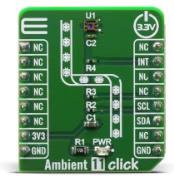
|
|
The Ambient 11 Click is a Click board™ equipped with the VEML6035, a low power, high sensitivity, I2C ambient light sensor from Vishay Semiconductors. Because of the possibilities its features offer, the Ambient 11 Click can be used as an ambient light sensor for mobile devices, industrial lighting operation, and as an optical switch for consumer, computing and industrial devices and displays.
Ambient 11 Click is supported by a mikroSDK compliant library, which includes functions that simplify software development. This Click board™ comes as a fully tested product, ready to be used on a system equipped with the mikroBUS™ socket.
|
|
|
|
|
 |
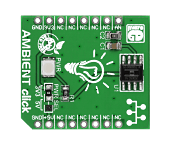
|
|
Ambient click carries the Melexis MLX75305 IC. It's a CMOS integrated optical sensor that consists of a photodiode, a transimpendance amplifier, and an output transistor. The chip converts ambient light intensity into a voltage, using the mikroBUS AN pin for communicating with the target board MCU. The board is designed to use either a 3.3V or a 5V power supply. |
|
|
|
 |
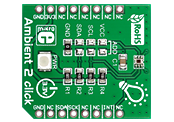
|
|
Ambient 2 click carries TI's OPT3001 Ambient Light sensor. This is a small (2mm x 2mm) single-chip lux meter that measures only the visible part of the light spectrum from any kind of source (mimicking the way humans see light). It does so by filtering out 99% of infrared light. The measurement range of Ambient 2 click is from 0.01 Lux to 83k lux, and a 23-bit resolution. Communication with the target MCU is done through mikroBUS I2C pins, with an additional INT pin which can be used for triggering wake-up events (offloading the MCU). |
|
|
|
 |
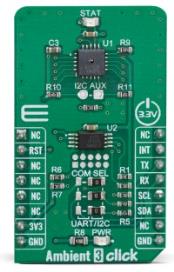
|
|
Ambient 3 Click is calibrated XYZ chromatic smart lighting director, providing the measurement data in digital format over the I2C interface. It utilizes the AS7225, a miniature light sensor with UART and I2C interfaces. Packed in a small casing, this sensor can provide calibrated for life nano-optic sensor providing direct CIE1931 XYZ and CIE 1976 u'v' coordinate mapping. A well-proven, integrated tristimulus sensing element designed to meet the XYZ standard observer response that mimic the human eye and is extremely stable over both operating temperature and time. The device contains a 16-bit integrating analog-to-digital converter, which integrates current from the photodiodes. To ensure the integrity of the data, upon completion of an integration cycle, results are transferred to double-buffered registers.
Ambient 3 click is supported by a mikroSDK compliant library, which includes functions that simplify software development. This Click board™ comes as a fully tested product, ready to be used on a system equipped with the mikroBUS™ socket.
|
|
|
|
 |
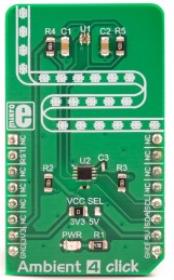
|
|
Ambient 4 click is a light intensity-sensing and measuring Click board™, which features an accurate, light-intensity sensor labeled as BH1721FVC, made by ROHM Corporation. It offers a high measurement accuracy in the range between 1x to 1.35x of the actual light intensity. The spectral response of the sensor is calibrated to closely match the spectral response of the human eye. Thanks to its high level of integration, the sensor requires a minimal number of external components, allowing the Click board™ to incorporate an additional level translating IC, ensuring a reliable data transfer over the industry-standard I2C interface. |
|
|
|
 |
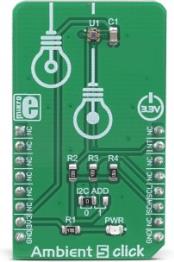
|
|
Ambient 5 click can sense the intensity of the ambient light, providing measurement data in a digital format, over the I2C interface. It utilizes the VEML6030, a miniature ambient light sensor (ALS) which occupies only 2x2 mm of space. Packed in a small transparent casing, this sensor offers a lot of features. Thanks to its 16-bit dynamic range, it can be used in very dim, but also in very bright lighting conditions. A Filtron™ technology provides spectral response close to a real human eye. The flicker noise rejection algorithm improves accuracy, while excellent thermal compensation ensures consistent readings.
Ambient 5 click is supported by a mikroSDK compliant library, which includes functions that simplify software development. This Click board™ comes as a fully tested product, ready to be used on a system equipped with the mikroBUS™ socket.
|
|
|
|
 |

|
|
Ambient 6 click can sense the intensity of the ambient light, providing the measurement data in digital format over the I2C interface. It utilizes the VEML7700, a miniature ambient light sensor (ALS) with I2C interface. Packed in a small transparent casing, this sensor can provide very accurate readings: thanks to a 16-bit dynamic range, it can be used in very dim and very bright lighting conditions. A well-proven Filtron™ technology allows response close to a real human eye, while the O-Trim™ technology allows for ALS tolerance less than 10%. The flicker noise rejection algorithm further improves accuracy, while excellent thermal compensation ensures consistency of the measurement results.
Ambient 6 click is supported by a mikroSDK compliant library, which includes functions that simplify software development. This Click board™ comes as a fully tested product, ready to be used on a system equipped with the mikroBUS™ socket.
|
|
|
|
 |
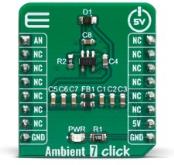
|
|
Ambient 7 Click is a light intensity-sensing and measuring Click board™, which features an accurate light-intensity sensor labeled as SFH 5701 A01, made by Osram Opto Semiconductors. It offers a high measurement accuracy in wide range of the actual light intensity. The spectral response of the sensor is calibrated to closely match the spectral response of the human eye. Thanks to its high level of integration, the sensor requires a minimal number of external components.
Ambient 7 click is supported by a mikroSDK compliant library, which includes functions that simplify software development. This Click board™ comes as a fully tested product, ready to be used on a system equipped with the mikroBUS™ socket.
|
|
|
|
 |

|
|
Ambient 8 click is equipped with the ambient light sensor (ALS) IC, providing measurements of the ambient light intensity in a digital format. It utilizes the LTR-329ALS-01, an ALS with the I2C interface. Packed in a small transparent ChipLED package, this sensor can provide very accurate readings: thanks to a 16-bit and resolution and high dynamic range, it can be used in both very dim and very bright lighting conditions: it can cover the range from 0.01 lx to 64 klx. It has an excellent IR filtering and two photo-sensing elements, allowing linear response over the whole range. The flicker noise rejection algorithm further improves accuracy, while excellent thermal compensation ensures consistency of the measurement results.
Ambient 8 click is supported by a mikroSDK compliant library, which includes functions that simplify software development. This Click board™ comes as a fully tested product, ready to be used on a system equipped with the mikroBUS™ socket.
|
|
|
|
 |
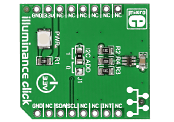
|
|
Illuminance click carries a TSL2561 light-to-digital converter with a sensor that's designed to mimic the way humans perceive light. This makes it ideal for applications where ambient lighting conditions have to be measured (backlight power-saving on LCD displays for example). The sensor has two photodiodes. One sensitive to full-spectrum light, the other to infrared. The visible-spectrum is then deduced by using a formula. Illuminance click communicates with the target board through mikroBUS I2C lines, and uses a 3.3V power supply. |
|
|
|
 |
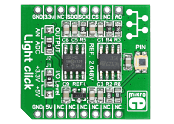
|
|
Light Click is the add-on board which features the PD15-22CTR8 PIN photodiode, providing an effective and easy way to measure ambient light intensity. It also features the MAX6106 voltage reference and MCP3201 ADC with SPI interface. Measured ambient light intensity is sent as an analog or digital signal to the main board microcontroller. Light Click communicates through mikroBUS SPI (MISO, SCK, CS) and AN lines. The PD15-22C-TR8 is a high photosensitive light sensor with fast response time. An SMD jumper allows the user to select whether the board will be powered with a 3.3V or 5V power supply. |
|
|
|
 |
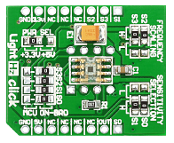
|
|
LightHz Click is an accessory board in the mikroBus form factor. The board features the TSL230BR programmable light-to-frequency converter. The output can be either a pulse train or a square wave (50% duty cycle), with frequency directly proportional to light intensity. Device sensitivity is selectable in three ranges, providing two decades of adjustment. The full-scale output frequency can be scaled by one of four preset values. The board features a voltage selection SMD jumper which determines whether it will operate on 5V or 3.3V. |
|
|
|
 |
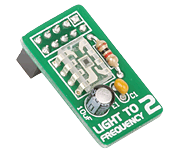
|
|
The Light to Frequency 2 Board enables you to connect your development board to a light-to-frequency converter. The board features a programmable light-to-frequency converter TSL230BR and is connected to a prototype device via an IDC10 connector. |
|
|
|
 |
|
|

